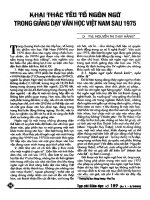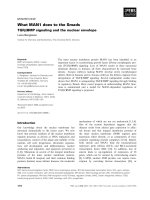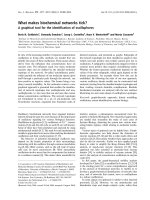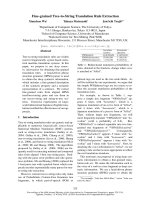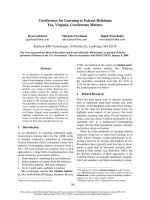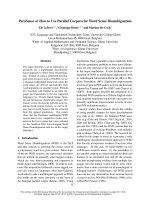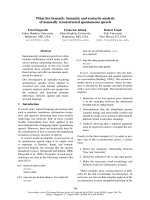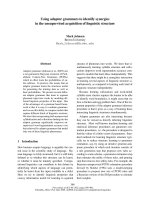Báo cáo khoa học: "What’s There to Talk About? A Multi-Modal Model of Referring Behavior in the Presence of Shared Visual Information" potx
Bạn đang xem bản rút gọn của tài liệu. Xem và tải ngay bản đầy đủ của tài liệu tại đây (162.7 KB, 8 trang )
What’s There to Talk About?
A Multi-Modal Model of Referring Behavior
in the Presence of Shared Visual Information
Darren Gergle
Human-Computer Interaction Institute
School of Computer Science
Carnegie Mellon University
Pittsburg, PA USA
dgergle+cs.cmu.edu
Abstract
This paper describes the development of
a rule-based computational model that
describes how a feature-based representa-
tion of shared visual information com-
bines with linguistic cues to enable effec-
tive reference resolution. This work ex-
plores a language-only model, a visual-
only model, and an integrated model of
reference resolution and applies them to a
corpus of transcribed task-oriented spo-
ken dialogues. Preliminary results from a
corpus-based analysis suggest that inte-
grating information from a shared visual
environment can improve the perform-
ance and quality of existing discourse-
based models of reference resolution.
1 Introduction
In this paper, we present work in progress to-
wards the development of a rule-based computa-
tional model to describe how various forms of
shared visual information combine with linguis-
tic cues to enable effective reference resolution
during task-oriented collaboration.
A number of recent studies have demonstrated
that linguistic patterns shift depending on the
speaker’s situational context. Patterns of prox-
imity markers (e.g., this/here vs. that/there)
change according to whether speakers perceive
themselves to be physically co-present or remote
from their partner (Byron & Stoia, 2005; Fussell
et al., 2004; Levelt, 1989). The use of particular
forms of definite referring expressions (e.g., per-
sonal pronouns vs. demonstrative pronouns vs.
demonstrative descriptions) varies depending on
the local visual context in which they are con-
structed (Byron et al., 2005a). And people are
found to use shorter and syntactically simpler
language (Oviatt, 1997) and different surface
realizations (Cassell & Stone, 2000) when ges-
tures accompany their spoken language.
More specifically, work examining dialogue
patterns in collaborative environments has dem-
onstrated that pairs adapt their linguistic patterns
based on what they believe their partner can see
(Brennan, 2005; Clark & Krych, 2004; Gergle et
al., 2004; Kraut et al., 2003). For example, when
a speaker knows their partner can see their ac-
tions but will incur a small delay before doing so,
they increase the proportion of full NPs used
(Gergle et al., 2004). Similar work by Byron and
colleagues (2005b) demonstrates that the forms
of referring expressions vary according to a part-
ner’s proximity to visual objects of interest.
Together this work suggests that the interlocu-
tors’ shared visual context has a major impact on
their patterns of referring behavior. Yet, a num-
ber of discourse-based models of reference pri-
marily rely on linguistic information without re-
gard to the surrounding visual environment (e.g.,
see Brennan et al., 1987; Hobbs, 1978; Poesio et
al., 2004; Strube, 1998; Tetreault, 2005). Re-
cently, multi-modal models have emerged that
integrate visual information into the resolution
process. However, many of these models are re-
stricted by their simplifying assumption of com-
munication via a command language. Thus, their
approaches apply to explicit interaction tech-
niques but do not necessarily support more gen-
eral communication in the presence of shared
visual information (e.g., see Chai et al., 2005;
Huls et al., 1995; Kehler, 2000).
It is the goal of the work presented in this pa-
per to explore the performance of language-
based models of reference resolution in contexts
where speakers share a common visual space. In
particular, we examine three basic hypotheses
7
regarding the likely impact of linguistic and vis-
ual salience on referring behavior. The first hy-
pothesis suggests that visual information is dis-
regarded and that linguistic context provides suf-
ficient information to describe referring behav-
ior. The second hypothesis suggests that visual
salience overrides any linguistic salience in gov-
erning referring behavior. Finally, the third hy-
pothesis posits that a balance of linguistic and
visual salience is needed in order to account for
patterns of referring behavior.
In the remainder of this paper, we begin by
presenting a brief discussion of the motivation
for this work. We then describe three computa-
tional models of referring behavior used to ex-
plore the hypotheses described above, and the
corpus on which they have been evaluated. We
conclude by presenting preliminary results and
discussing future modeling plans.
2 Motivation
There are several motivating factors for develop-
ing a computational model of referring behavior
in shared visual contexts. First, a model of refer-
ring behavior that integrates a component of
shared visual information can be used to increase
the robustness of interactive agents that converse
with humans in real-world situated environ-
ments. Second, such a model can be applied to
the development of a range of technologies to
support distributed group collaboration and me-
diated communication. Finally, such a model can
be used to provide a deeper theoretical under-
standing of how humans make use of various
forms of shared visual information in their every-
day communication.
The development of an integrated multi-modal
model of referring behavior can improve the per-
formance of state-of-the-art computational mod-
els of communication currently used to support
conversational interactions with an intelligent
agent (Allen et al., 2005; Devault et al., 2005;
Gorniak & Roy, 2004). Many of these models
rely on discourse state and prior linguistic con-
tributions to successfully resolve references in a
given utterance. However, recent technological
advances have created opportunities for human-
human and human-agent interactions in a wide
variety of contexts that include visual objects of
interest. Such systems may benefit from a data-
driven model of how collaborative pairs adapt
their language in the presence (or absence) of
shared visual information. A successful computa-
tional model of referring behavior in the pres-
ence of visual information could enable agents to
emulate many elements of more natural and real-
istic human conversational behavior.
A computational model may also make valu-
able contributions to research in the area of com-
puter-mediated communication. Video-mediated
communication systems, shared media spaces,
and collaborative virtual environments are tech-
nologies developed to support joint activities
between geographically distributed groups.
However, the visual information provided in
each of these technologies can vary drastically.
The shared field of view can vary, views may be
misaligned between speaking partners, and de-
lays of the sort generated by network congestion
may unintentionally disrupt critical information
required for successful communication (Brennan,
2005; Gergle et al., 2004). Our proposed model
could be used along with a detailed task analysis
to inform the design and development of such
technologies. For instance, the model could in-
form designers about the times when particular
visual elements need to be made more salient in
order to support effective communication. A
computational model that can account for visual
salience and understand its impact on conversa-
tional coherence could inform the construction of
shared displays or dynamically restructure the
environment as the discourse unfolds.
A final motivation for this work is to further
our theoretical understanding of the role shared
visual information plays during communication.
A number of behavioral studies have demon-
strated the need for a more detailed theoretical
understanding of human referring behavior in the
presence of shared visual information. They sug-
gest that shared visual information of the task
objects and surrounding workspace can signifi-
cantly impact collaborative task performance and
communication efficiency in task-oriented inter-
actions (Kraut et al., 2003; Monk & Watts, 2000;
Nardi et al., 1993; Whittaker, 2003). For exam-
ple, viewing a partner’s actions facilitates moni-
toring of comprehension and enables efficient
object reference (Daly-Jones et al., 1998), chang-
ing the amount of available visual information
impacts information gathering and recovery from
ambiguous help requests (Karsenty, 1999), and
varying the field of view that a remote helper has
of a co-worker’s environment influences per-
formance and shapes communication patterns in
directed physical tasks (Fussell et al., 2003).
Having a computational description of these
processes can provide insight into why they oc-
cur, can expose implicit and possibly inadequate
simplifying assumptions underlying existing
8
theoretical models, and can serve as a guide for
future empirical research.
3 Background and Related Work
A review of the computational linguistics lit-
erature reveals a number of discourse models
that describe referring behaviors in written, and
to a lesser extent, spoken discourse (for a recent
review see Tetreault, 2005). These include mod-
els based primarily on world knowledge (e.g.,
Hobbs et al., 1993), syntax-based methods
(Hobbs, 1978), and those that integrate a combi-
nation of syntax, semantics and discourse struc-
ture (e.g., Grosz et al., 1995; Strube, 1998;
Tetreault, 2001). The majority of these models
are salience-based approaches where entities are
ranked according to their grammatical function,
number of prior mentions, prosodic markers, etc.
In typical language-based models of reference
resolution, the licensed referents are introduced
through utterances in the prior linguistic context.
Consider the following example drawn from the
PUZZLE CORPUS
1
whereby a “Helper” describes to
a “Worker” how to construct an arrangement of
colored blocks so they match a solution only the
Helper has visual access to:
(1) Helper: Take the dark red piece.
Helper: Overlap it over the orange halfway.
In excerpt (1), the first utterance uses the defi-
nite-NP “the dark red piece,” to introduce a new
discourse entity. This phrase specifies an actual
puzzle piece that has a color attribute of dark red
and that the Helper wants the Worker to position
in their workspace. Assuming the Worker has
correctly heard the utterance, the Helper can now
expect that entity to be a shared element as estab-
lished by prior linguistic context. As such, this
piece can subsequently be referred to using a
pronoun. In this case, most models correctly li-
cense the observed behavior as the Helper speci-
fies the piece using “it” in the second utterance.
3.1 A Drawback to Language-Only Models
However, as described in Section 2, several be-
havioral studies of task-oriented collaboration
have suggested that visual context plays a critical
role in determining which objects are salient
parts of a conversation. The following example
from the same
PUZZLE CORPUS—in this case from
a task condition in which the pairs share a visual
space—demonstrates that it is not only the lin-
guistic context that determines the potential ante-
1
The details of the PUZZLE CORPUS are described in §.4.
cedents for a pronoun, but also the physical con-
text as well:
(2) Helper: Alright, take the dark orange block.
Worker: OK.
Worker: [ moved an incorrect piece ]
Helper: Oh, that’s not it.
In excerpt (2), both the linguistic and visual
information provide entities that could be co-
specified by a subsequent referent. In this ex-
cerpt, the first pronoun “that,” refers to the “[in-
correct piece]” that was physically moved into
the shared visual workspace but was not previ-
ously mentioned. While the second pronoun,
“it,” has as its antecedent the object co-specified
by the definite-NP “the dark orange block.” This
example demonstrates that during task-oriented
collaborations both the linguistic and visual con-
texts play central roles in enabling the conversa-
tional pairs to make efficient use of communica-
tion tactics such as pronominalization.
3.2 Towards an Integrated Model
While most computational models of reference
resolution accurately resolve the pronoun in ex-
cerpt (1), many fail at resolving one or more of
the pronouns in excerpt (2). In this rather trivial
case, if no method is available to generate poten-
tial discourse entities from the shared visual en-
vironment, then the model cannot correctly re-
solve pronouns that have those objects as their
antecedents.
This problem is compounded in real-world
and computer-mediated environments since the
visual information can take many forms. For in-
stance, pairs of interlocutors may have different
perspectives which result in different objects be-
ing occluded for the speaker and for the listener.
In geographically distributed collaborations a
conversational partner may only see a subset of
the visual space due to a limited field of view
provided by a camera. Similarly, the speed of the
visual update may be slowed by network conges-
tion.
Byron and colleagues recently performed a
preliminary investigation of the role of shared
visual information in a task-oriented, human-to-
human collaborative virtual environment (Byron
et al., 2005b). They compared the results of a
language-only model with a visual-only model,
and developed a visual salience algorithm to rank
the visual objects according to recency, exposure
time, and visual uniqueness. In a hand-processed
evaluation, they found that a visual-only model
accounted for 31.3% of the referring expressions,
and that adding semantic restrictions (e.g., “open
9
that” could only match objects that could be
opened, such as a door) increased performance to
52.2%. These values can be compared with a
language-only model with semantic constraints
that accounted for 58.2% of the referring expres-
sions.
While Byron’s visual-only model uses seman-
tic selection restrictions to limit the number of
visible entities that can be referenced, her model
differs from the work reported here in that it does
not make simultaneous use of linguistic salience
information based on the discourse content. So,
for example, referring expressions cannot be re-
solved to entities that have been mentioned but
which are not visible. Furthermore, all other
things equal, it will not correctly resolve refer-
ences to objects that are most salient based on
the linguistic context over the visual context.
Therefore, in addition to language-only and vis-
ual-only models, we explore the development of
an integrated model that uses both linguistic and
visual salience to support reference resolution.
We also extend these models to a new task do-
main that can elaborate on referential patterns in
the presence of various forms of shared visual
information. Finally, we make use of a corpus
gathered from laboratory studies that allow us to
decompose the various features of shared visual
information in order to better understand their
independent effects on referring behaviors.
The following section provides an overview of
the task paradigm used to collect the data for our
corpus evaluation. We describe the basic ex-
perimental paradigm and detail how it can be
used to examine the impact of various features of
a shared visual space on communication.
4 The Puzzle Task Corpus
The corpus data used for the development of the
models in this paper come from a subset of data
collected over the past few years using a referen-
tial communication task called the puzzle study
(Gergle et al., 2004).
In this task, pairs of participants are randomly
assigned to play the role of “Helper” or
“Worker.” It is the goal of the task for the Helper
to successfully describe a configuration of pieces
to the Worker, and for the Worker to correctly
arrange the pieces in their workspace. The puzzle
solutions, which are only provided to the Helper,
consist of four blocks selected from a larger set
of eight. The goal is to have the Worker correctly
place the four solution pieces in the proper con-
figuration as quickly as possible so that they
match the target solution the Helper is viewing.
Each participant was seated in a separate room
in front of a computer with a 21-inch display.
The pairs communicated over a high-quality,
full-duplex audio link with no delay. The ex-
perimental displays for the Worker and Helper
are illustrated in Figure 1.
Figure 1. The Worker’s view (left) and the
Helper’s view (right).
The Worker’s screen (left) consists of a stag-
ing area on the right hand side where the puzzle
pieces are held, and a work area on the left hand
side where the puzzle is constructed. The
Helper’s screen (right) shows the target solution
on the right, and a view of the Worker’s work
area in the left hand panel. The advantage of this
setup is that it allows exploration of a number of
different arrangements of the shared visual
space. For instance, we have varied the propor-
tion of the workspace that is visually shared with
the Helper in order to examine the impact of a
limited field-of-view. We have offset the spatial
alignment between the two displays to simulate
settings of various video systems. And we have
added delays to the speed with which the Helper
receives visual feedback of the Worker’s actions
in order to simulate network congestion.
Together, the data collected using the puzzle
paradigm currently contains 64,430 words in the
form of 10,640 contributions collected from over
100 different pairs. Preliminary estimates suggest
that these data include a rich collection of over
5,500 referring expressions that were generated
across a wide range of visual settings. In this pa-
per, we examine a small portion of the data in
order to assess the feasibility and potential con-
tribution of the corpus for model development.
4.1 Preliminary Corpus Overview
The data collected using this paradigm includes
an audio capture of the spoken conversation sur-
rounding the task, written transcriptions of the
spoken utterances, and a time-stamped record of
all the piece movements and their representative
state in the shared workspace (e.g., whether they
are visible to both the Helper and Worker). From
10
these various streams of data we can parse and
extract the units for inclusion in our models.
For initial model development, we focus on
modeling two primary conditions from the PUZ-
ZLE CORPUS. The first is the “No Shared Visual
Information” condition where the Helper could
not see the Worker’s workspace at all. In this
condition, the pair needs to successfully com-
plete the tasks using only linguistic information.
The second is the “Shared Visual Information”
condition, where the Helper receives immediate
visual feedback about the state of the Worker’s
work area. In this case, the pairs can make use of
both linguistic information and shared visual in-
formation in order to successfully complete the
task.
As Table 1 demonstrates, we use a small ran-
dom selection of data consisting of 10 dialogues
from each of the Shared Visual Information and
No Shared Visual Information conditions. Each
of these dialogues was collected from a unique
participant pair. For this evaluation, we focused
primarily on pronoun usage since this has been
suggested to be one of the major linguistic effi-
ciencies gained when pairs have access to a
shared visual space (Kraut et al., 2003).
Task
Condition
Corpus
Statistics
Dialogues
Contri-
butions
Words
Pro-
nouns
No Shared
Visual
Information
10 218 1181 30
Shared
Visual
Information
10 174 938 39
Total
20 392 2119 69
Table 1. Overview of the data used.
5 Preliminary Model Overviews
The models evaluated in this paper are based
on Centering Theory (Grosz et al., 1995; Grosz
& Sidner, 1986) and the algorithms devised by
Brennan and colleagues (1987) and adapted by
Tetreault (2001). We examine a language-only
model based on Tetreault’s Left-Right Centering
(LRC) model, a visual-only model that uses a
measure of visual salience to rank the objects in
the visual field as possible referential anchors,
and an integrated model that balances the visual
information along with the linguistic information
to generate a ranked list of possible anchors.
5.1 The Language-Only Model
We chose the LRC algorithm (Tetreault, 2001) to
serve as the basis for our language-only model. It
has been shown to fare well on task-oriented spo-
ken dialogues (Tetreault, 2005) and was easily
adapted to the PUZZLE CORPUS data.
LRC uses grammatical function as a central
mechanism for resolving the antecedents of ana-
phoric references. It resolves referents by first
searching in a left-to-right fashion within the cur-
rent utterance for possible antecedents. It then
makes co-specification links when it finds an
antecedent that adheres to the selectional restric-
tions based on verb argument structure and
agreement in terms of number and gender. If a
match is not found the algorithm then searches
the lists of possible antecedents in prior utter-
ances in a similar fashion.
The primary structure employed in the lan-
guage-only model is a ranked entity list sorted by
linguistic salience. To conserve space we do not
reproduce the LRC algorithm in this paper and
instead refer readers to Tetreault’s original for-
mulation (2001). We determined order based on
the following precedence ranking:
Subject
%
Direct Object
%
Indirect Object
Any remaining ties (e.g., an utterance with two
direct objects) were resolved according to a left-
to-right breadth-first traversal of the parse tree.
5.2 The Visual-Only Model
As the Worker moves pieces into their work-
space, depending on whether or not the work-
space is shared with the Helper, the objects be-
come available for the Helper to see. The visual-
only model utilized an approach based on visual
salience. This method captures the relevant vis-
ual objects in the puzzle task and ranks them ac-
cording to the recency with which they were ac-
tive (as described below).
Given the highly controlled visual environ-
ment that makes up the PUZZLE CORPUS, we have
complete access to the visual pieces and exact
timing information about when they become
visible, are moved, or are removed from the
shared workspace. In the visual-only model, we
maintain an ordered list of entities that comprise
the shared visual space. The entities are included
in the list if they are currently visible to both the
Helper and Worker, and then ranked according to
the recency of their activation.
2
2
This allows for objects to be dynamically rearranged de-
pending on when they were last ‘touched’ by the Worker.
11
5.3 The Integrated Model
We used the salience list generated from the lan-
guage-only model and integrated it with the one
from the visual-only model. The method of or-
dering the integrated list resulted from general
perceptual psychology principles that suggest
that highly active visual objects attract an indi-
vidual’s attentional processes (Scholl, 2001).
In this preliminary implementation, we de-
fined active objects as those objects that had re-
cently moved within the shared workspace.
These objects are added to the top of the linguis-
tic-salience list which essentially rendered them
as the focus of the joint activity. However, peo-
ple’s attention to static objects has a tendency to
fade away over time. Following prior work that
demonstrated the utility of a visual decay func-
tion (Byron et al., 2005b; Huls et al., 1995), we
implemented a three second threshold on the
lifespan of a visual entity. From the time since
the object was last active, it remained on the list
for three seconds. After the time expired, the ob-
ject was removed and the list returned to its prior
state. This mechanism was intended to capture
the notion that active objects are at the center of
shared attention in a collaborative task for a short
period of time. After that the interlocutors revert
to their recent linguistic history for the context of
an interaction.
It should be noted that this is work in progress
and a major avenue for future work is the devel-
opment of a more theoretically grounded method
for integrating linguistic salience information
with visual salience information.
5.4 Evaluation Plan
Together, the models described above allow us to
test three basic hypotheses regarding the likely
impact of linguistic and visual salience:
Purely linguistic context. One hypothesis is
that the visual information is completely disre-
garded and the entities are salient purely based
on linguistic information. While our prior work
has suggested this should not be the case, several
existing computational models function only at
this level.
Purely visual context. A second possibility is
that the visual information completely overrides
linguistic salience. Thus, visual information
dominates the discourse structure when it is
available and relegates linguistic information to a
subordinate role. This too should be unlikely
given the fact that not all discourse deals with
external elements from the surrounding world.
A balance of syntactic and visual context. A
third hypothesis is that both linguistic entities
and visual entities are required in order to accu-
rately and perspicuously account for patterns of
observed referring behavior. Salient discourse
entities result from some balance of linguistic
salience and visual salience.
6 Preliminary Results
In order to investigate the hypotheses described
above, we examined the performance of the
models using hand-processed evaluations of the
PUZZLE CORPUS data. The following presents the
results of the three different models on 10 trials
of the PUZZLE CORPUS in which the pairs had no
shared visual space, and 10 trials from when the
pairs had access to shared visual information rep-
resenting the workspace. Two experts performed
qualitative coding of the referential anchors for
each pronoun in the corpus with an overall
agreement of 88% (the remaining anomalies
were resolved after discussion).
As demonstrated in Table 2, the language-only
model correctly resolved 70% of the referring
expressions when applied to the set of dialogues
where only language could be used to solve the
task (i.e., the no shared visual information condi-
tion). However, when the same model was ap-
plied to the dialogues from the task conditions
where shared visual information was available, it
only resolved 41% of the referring expressions
correctly. This difference was significant,
2
(1,
N=69) = 5.72, p = .02.
No Shared Visual
Information
Shared Visual
Information
Language
Model
70.0% (21 / 30) 41.0% (16 / 39)
Visual
Model
n/a 66.7% (26 / 39)
Integrated
Model
70.0% (21 / 30) 69.2% (27 / 39)
Table 2. Results for all pronouns in the subset
of the PUZZLE CORPUS evaluated.
In contrast, when the visual-only model was
applied to the same data derived from the task
conditions in which the shared visual information
was available, the algorithm correctly resolved
66.7% of the referring expressions. In compari-
son to the 41% produced by the language-only
model. This difference was also significant,
2
(1,
N=78) = 5.16, p = .02. However, we did not find
evidence of a difference between the perform-
ance of the visual-only model on the visual task
conditions and the language-only model on the
12
language task conditions,
2
(1, N=69) = .087, p =
.77 (n.s.).
The integrated model with the decay function
also performed reasonably well. When the inte-
grated model was evaluated on the data where
only language could be used it effectively reverts
back to a language-only model, therefore achiev-
ing the same 70% performance. Yet, when it was
applied to the data from the cases when the pairs
had access to the shared visual information it
correctly resolved 69.2% of the referring expres-
sions. This was also better than the 41% exhib-
ited by the language-only model,
2
(1, N=78) =
6.27, p = .012; however, it did not statistically
outperform the visual-only model on the same
data,
2
(1, N=78) = .059, p = .81 (n.s.).
In general, we found that the language-only
model performed reasonably well on the dia-
logues in which the pairs had no access to shared
visual information. However, when the same
model was applied to the dialogues collected
from task conditions where the pairs had access
to shared visual information the performance of
the language-only model was significantly re-
duced. However, both the visual-only model and
the integrated model significantly increased per-
formance. The goal of our current work is to find
a better integrated model that can achieve sig-
nificantly better performance than the visual-
only model. As a starting point for this investiga-
tion, we present an error analysis below.
6.1 Error Analysis
In order to inform further development of the
model, we examined a number of failure cases
with the existing data. The first thing to note was
that a number of the pronouns used by the pairs
referred to larger visible structures in the work-
space. For example, the Worker would some-
times state, “like this?”, and ask the Helper to
comment on the overall configuration of the puz-
zle. Table 3 presents the performance results of
the models after removing all expressions that
did not refer to pieces of the puzzle.
No Shared Visual
Information
Shared Visual
Information
Language
Model
77.7% (21 / 27) 47.0% (16 / 34)
Visual
Model
n/a 76.4% (26 / 34)
Integrated
Model
77.7% (21 / 27) 79.4% (27 / 34)
Table 3. Model performance results when re-
stricted to piece referents.
In the errors that remained, the language-only
model had a tendency to suffer from a number of
higher-order referents such as events and actions.
In addition, there were several errors that re-
sulted from chaining errors where the initial ref-
erent was misidentified. As a result, all subse-
quent chains of referents were incorrect.
The visual-only model and the integrated
model had a tendency to suffer from timing is-
sues. For instance, the pairs occasionally intro-
duced a new visual entity with, “this one?” How-
ever, the piece did not appear in the workspace
until a short time after the utterance was made.
In such cases, the object was not available as a
referent on the object list. In the future we plan
to investigate the temporal alignment between
the visual and linguistic streams.
In other cases, problems simply resulted from
the unique behaviors present when exploring
human activities. Take the following example,
(3) Helper: There is an orange red that obscures
half of it and it is to the left of it
In this excerpt, all of our models had trouble
correctly resolving the pronouns in the utterance.
However, while this counts as a strike against the
model performance, the model actually presented
a true account of human behavior. While the
model was confused, so was the Worker. In this
case, it took three more contributions from the
Helper to unravel what was actually intended.
7 Future Work
In the future, we plan to extend this work in
several ways. First, we plan future studies to help
expand our notion of visual salience. Each of the
visual entities has an associated number of do-
main-dependent features. For example, they may
have appearance features that contribute to over-
all salience, become activated multiple times in a
short window of time, or be more or less salient
depending on nearby visual objects. We intend to
explore these parameters in detail.
Second, we plan to appreciably enhance the
integrated model. It appears from both our initial
data analysis, as well as our qualitative examina-
tion of the data, that the pairs make tradeoffs be-
tween relying on the linguistic context and the
visual context. Our current instantiation of the
integrated model could be enhanced by taking a
more theoretical approach to integrating the in-
formation from multiple streams.
Finally, we plan to perform a large-scale com-
putational evaluation of the entire
PUZZLE CORPUS
in order to examine a much wider range of visual
13
features such as limited field-of-views, delays in
providing the shared visual information, and
various asymmetries in the interlocutors’ visual
information. In addition to this we plan to extend
our model to a wider range of task domains in
order to explore the generality of its predictions.
Acknowledgments
This research was funded in by an IBM Ph.D.
Fellowship. I would like to thank Carolyn Rosé
and Bob Kraut for their support.
References
Allen, J., Ferguson, G., Swift, M., Stent, A., Stoness, S.,
Galescu, L., et al. (2005). Two diverse systems built using
generic components for spoken dialogue. In Proceedings
of Association for Computational Linguistics, Companion
Vol., pp. 85-88.
Brennan, S. E. (2005). How conversation is shaped by vis-
ual and spoken evidence. In J. C. Trueswell & M. K. Ta-
nenhaus (Eds.), Approaches to studying world-situated
language use: Bridging the language-as-product and lan-
guage-as-action traditions (pp. 95-129). Cambridge, MA:
MIT Press.
Brennan, S. E., Friedman, M. W., & Pollard, C. J. (1987). A
centering approach to pronouns. In Proceedings of 25th
Annual Meeting of the Association for Computational Lin-
guistics, pp. 155-162.
Byron, D. K., Dalwani, A., Gerritsen, R., Keck, M., Mam-
pilly, T., Sharma, V., et al. (2005a). Natural noun phrase
variation for interactive characters. In Proceedings of 1st
Annual Artificial Intelligence and Interactive Digital En-
tertainment Conference, pp. 15-20. AAAI.
Byron, D. K., Mampilly, T., Sharma, V., & Xu, T. (2005b).
Utilizing visual attention for cross-modal coreference in-
terpretation. In Proceedings of Fifth International and In-
terdisciplinary Conference on Modeling and Using Con-
text (CONTEXT-05), pp.
Byron, D. K., & Stoia, L. (2005). An analysis of proximity
markers in collaborative dialog. In Proceedings of 41st an-
nual meeting of the Chicago Linguistic Society, pp. Chi-
cago Linguistic Society.
Cassell, J., & Stone, M. (2000). Coordination and context-
dependence in the generation of embodied conversation. In
Proceedings of International Natural Language Genera-
tion Conference, pp. 171-178.
Chai, J. Y., Prasov, Z., Blaim, J., & Jin, R. (2005). Linguis-
tic theories in efficient multimodal reference resolution:
An empirical investigation. In Proceedings of Intelligent
User Interfaces, pp. 43-50. NY: ACM Press.
Clark, H. H., & Krych, M. A. (2004). Speaking while moni-
toring addressees for understanding. Journal of Memory &
Language, 50(1), 62-81.
Daly-Jones, O., Monk, A., & Watts, L. (1998). Some advan-
tages of video conferencing over high-quality audio con-
ferencing: Fluency and awareness of attentional focus. In-
ternational Journal of Human-Computer Studies, 49, 21-
58.
Devault, D., Kariaeva, N., Kothari, A., Oved, I., & Stone,
M. (2005). An information-state approach to collaborative
reference. In Proceedings of Association for Computa-
tional Linguistics, Companion Vol., pp.
Fussell, S. R., Setlock, L. D., & Kraut, R. E. (2003). Effects
of head-mounted and scene-oriented video systems on re-
mote collaboration on physical tasks. In Proceedings of
Human Factors in Computing Systems (CHI '03), pp. 513-
520. ACM Press.
Fussell, S. R., Setlock, L. D., Yang, J., Ou, J., Mauer, E. M.,
& Kramer, A. (2004). Gestures over video streams to sup-
port remote collaboration on physical tasks. Human-
Computer Interaction, 19, 273-309.
Gergle, D., Kraut, R. E., & Fussell, S. R. (2004). Language
efficiency and visual technology: Minimizing collabora-
tive effort with visual information. Journal of Language &
Social Psychology, 23(4), 491-517.
Gorniak, P., & Roy, D. (2004). Grounded semantic compo-
sition for visual scenes. Journal of Artificial Intelligence
Research, 21, 429-470.
Grosz, B. J., Joshi, A. K., & Weinstein, S. (1995). Center-
ing: A framework for modeling the local coherence of dis-
course. Computational Linguistics, 21(2), 203-225.
Grosz, B. J., & Sidner, C. L. (1986). Attention, intentions
and the structure of discourse. Computational Linguistics,
12(3), 175-204.
Hobbs, J. R. (1978). Resolving pronoun references. Lingua,
44, 311-338.
Hobbs, J. R., Stickel, M. E., Appelt, D. E., & Martin, P.
(1993). Interpretation as abduction. Artificial Intelligence,
63, 69-142.
Huls, C., Bos, E., & Claassen, W. (1995). Automatic refer-
ent resolution of deictic and anaphoric expressions. Com-
putational Linguistics, 21(1), 59-79.
Karsenty, L. (1999). Cooperative work and shared context:
An empirical study of comprehension problems in side by
side and remote help dialogues. Human-Computer Interac-
tion, 14(3), 283-315.
Kehler, A. (2000). Cognitive status and form of reference in
multimodal human-computer interaction. In Proceedings
of American Association for Artificial Intelligence (AAAI
2000), pp. 685-689.
Kraut, R. E., Fussell, S. R., & Siegel, J. (2003). Visual in-
formation as a conversational resource in collaborative
physical tasks. Human Computer Interaction, 18, 13-49.
Levelt, W. J. M. (1989). Speaking: From intention to articu-
lation. Cambridge, MA: MIT Press.
Monk, A., & Watts, L. (2000). Peripheral participation in
video-mediated communication. International Journal of
Human-Computer Studies, 52(5), 933-958.
Nardi, B., Schwartz, H., Kuchinsky, A., Leichner, R.,
Whittaker, S., & Sclabassi, R. T. (1993). Turning away
from talking heads: The use of video-as-data in neurosur-
gery. In Proceedings of Interchi '93, pp. 327-334.
Oviatt, S. L. (1997). Multimodal interactive maps: Design-
ing for human performance. Human-Computer Interaction,
12, 93-129.
Poesio, M., Stevenson, R., Di Eugenio, B., & Hitzeman, J.
(2004). Centering: A parametric theory and its instantia-
tions. Computational Linguistics, 30(3), 309-363.
Scholl, B. J. (2001). Objects and attention: the state of the
art. Cognition, 80, 1-46.
Strube, M. (1998). Never look back: An alternative to cen-
tering. In Proceedings of 36th Annual Meeting of the Asso-
ciation for Computational Linguistics, pp. 1251-1257.
Tetreault, J. R. (2001). A corpus-based evaluation of center-
ing and pronoun resolution. Computational Linguistics,
27(4), 507-520.
Tetreault, J. R. (2005). Empirical evaluations of pronoun
resolution. Unpublished doctoral thesis, University of
Rochester, Rochester, NY.
Whittaker, S. (2003). Things to talk about when talking
about things. Human-Computer Interaction, 18, 149-170.
14
